- Home
- Rudy Rucker
Complete Stories Page 5
Complete Stories Read online
Page 5
Two of the thin, inflexible quarkonium plates were square, and four were longish rectangles. I assembled the six into a box, setting an evacuation nozzle into the hole with which one plate had been provided. The material was strange to work with, slippery and utterly rigid. Although they were supposed to be a sort of mirror, the plates did not reflect images in any ordinary way…at least not most of the time. But, over and over, as I was assembling the phase-mirrors into a box, I seemed to glimpse isolated images of my fingertips here and there on the mirrors’ surfaces.
We spent forty-eight hours pumping the box out to a state of near-perfect vacuum, and then sealed it off. While the pump was running, Ion instructed me to mount a series of wire loops on the table, loops which could be charged to produce a weakly guiding magnetic field. We set the box in the middle of the loops, and that was about it. A transparent box like an aquarium with a glass top. Ion called the box a time-tunnel, but I found this colorful description misleading.
We ran our first tests with an electron beam. The idea was that a signal could come out of one end of the box before it went in the other. It’s called an advanced potential in quantum mechanics. We got the results Ion had predicted, so we moved up to atomic nuclei, and then to a series of larger and larger iron bullets.
Shooting the bullets into that phase-mirror box made me a little nervous… . I expected the box to shatter. But somehow it didn’t. I assumed it was because the quarkonium plates were, in some sense, liquid, and thus able to close up after a rapid enough object.
I believed that for a while, anyway. But before long I had come to believe something stranger…that the box was able to create and destroy matter/antimatter pairs. But where was the energy coming from? And where did it go?
Ion had an explanation. But I was not ready to accept his description of what we had built. That way lay madness.
“Do you know what your husband and I have done?” I asked Klara at lunch the last day of February. The twins had already left the table to do their homework. I glanced at Ion, and he gave me an encouraging nod. Until now I had been sworn to silence.
Klara looked a bit nervous at my question. Ion was, I had learned, something of a philanderer. What a fool to betray a woman as wonderful as Klara!
“Nothing too depraved, I hope?” Her voice was gay, but with the faintest tremolo of real worry. She drew out a cigarette and placed it between her wonderful lips, waiting for the touch of my lighter…the lighter which I had bought solely so that I could light Klara’s cigarettes. She tilted her head back, away from the smoke, and looked at Ion questioningly.
He smiled his broad, mirthless smile. “William and I have assembled a rather interesting piece of apparatus. It creates and destroys matter, according to William’s way of looking at things.”
Klara arched her eyebrows at me. “Is that true, William? Perhaps you have solved the energy crisis?”
I laughed, a bit exasperated by Ion’s misdirection. “No, no. This is a very expensive machine to build. We have used most of the quarkonium in the world to build it. And really it creates and absorbs matter/antimatter pairs, rather than just matter. But Ion thinks …
Ion was pouring himself a glass of wine, and the carafe clattered against his glass. “I do not think, William, I know. We have built a time-machine.” Suddenly, on some level, we were fighting over Klara.
She blew a thick stream of smoke and put out her cigarette. “I would like a time-machine. Then I could see what the castle looked like in 1400, before the French blew it up. And I’d like to see dinosaurs. And fashions one thousand years from now.” It was clear she didn’t believe Ion. “Dearest, do you think you could bring me back a kitchen-robot from the future? It would be even nicer than that dishwasher you’re always promising to get me!”
Ion was breathing heavily. He had had several glasses of kirsch before lunch. This quarrel had been brewing for three months. I thought his experiment interesting, but I saw no reason to take Feynman’s theory so literally as to assert that we had produced time-travel. Ion could see this in my eyes.
He stood up suddenly, almost as if to attack me. Was he, on top of it all, jealous of my attentions to Klara? New Year’s Eve, after he had passed out, Klara and I, how close we had come! I tried to keep this out of my eyes. I stood up clumsily, and my chair fell to the floor behind me.
“Don’t panic, William,” Ion said, shrugging on his suede jacket. “I only thought we could give Klara a demonstration.”
The twins, attracted by the noise of my chair, had come running in from the study, and insisted that they too be allowed to come see Daddy’s machine. Ion acquiesced, on the condition that they bring a certain toy.
We all bundled into our coats…Klara wore a charming fox coat sewed in herring-bone strips…and we walked the three blocks to the Physics Institute.
The twins ran ahead of us, screaming and trying to slide on the frozen puddles. Klara walked between Ion and me, linking an arm with each of us. The sky was low and grey. The eternal mist seemed to form a circular wall around us, always ten meters off.
“Should we show Klara the bullet series?” I asked Ion, speaking across Klara’s lovely, upturned face.
Ion pursed his lips and shook his head. “Too fast. Klara has to see it to believe it.”
“Believe what?”
“We have a sort of tunnel,” I explained. “The size of a toy train tunnel. And if we shoot a bullet through it, the bullet seems to come out the right end before it goes in the left.”
Klara laughed. “Now that sounds useful. We could use one of your machines in the tunnel under the castle…where those dreadful traffic jams are.”
“Actually,” Ion said, “I thought I would use a little car today—the little three-wheeler that I helped the twins make last night.”
The twins had brought the little car, a bright red-yellow-blue mass of Lego blocks. On the top was a battery-run motor, with a cog wheel linked by a black plastic chain to a gear on the single front wheel.
Klara examined our “time-tunnel” with interest. The core of it was the shoe-box-sized vacuum chamber made of phase-mirrors. You could see in quite easily. The thick loops of the guiding-field wires arched over the box like croquet wickets.
I removed the rifle from its mount on one end of the lab-table, and waited while Ion got the car from the little girls.
Then, bustling a bit, he lined up his three women in chairs against the wall, and set the car down at one end of the table. I cleared my throat, preparatory to telling them what they might expect, but Ion shushed me.
“First let them see, and then we’ll discuss it.”
I taped an iron nail to the bottom of the Lego car, and dialed the guiding-field’s power up to some hundred times the level we had used before. The Lego car made a pretty big test-particle.
In all frankness, I expected the experiment to be a failure. The car would roll up to the phase-mirror box, bump into the side and stop…nothing more. But I was wrong.
As the little car labored across the table towards the left end of the box, something happened at the right end. Seemingly out of no place, an identical Lego car pushed out of the right end of the tunnel and went chuffing on its way! “And there’s one inside now, rolling left!” Klara exclaimed, leaning forward. She was right. For a few seconds there were three Lego cars on the table.
Car (1): The original car, still approaching the tunnel’s left entrance. Car (2): The one moving in the tunnel, from right to left. Car (3): The new one moving away from the right end of the tunnel.
And then car (1) and car (2) met at the left-end mirror. They melted into each other…nose into nose, wheel into wheel, tail into tail. It was like watching a Rorschach ink-blot disappear into its central fold.
One of the twins squealed and ran to catch car (3) before it ran off the other end of the lab table. I took it from her and examined it closely. Car (3) appeared to be identical to car (1). We had already done this experiment with electrons and with small
bullets…but one bullet or electron is much like another. Until now I had been unwilling to accept Ion’s interpretation of our experiment. But it certainly looked as if car (3) really was car (1).
Ion stepped to the blackboard and drew a diagram.
“Look,” he said to Klara. “Here’s a spacetime diagram of what happens. If we think of the zigzag line as the history of a particular object, what we have is this: First, car (1) goes forward in time till it gets to the left phase-mirror. Second, inside the tunnel it flips and moves backwards in time, but still left-to-right, and we call it car (2). Third, upon passing through another phase-mirror it flips back to run forward in time again, and is called car (3). By evolving into car (3), the original car (1) manages to come out of the right end a few seconds earlier than it goes in the left.”
“That’s one way of looking at it,” I interrupted. “But we can read the picture a bit differently. Just think of moving that space-axis upwards through time, and see what happens. First there’s just car (1) moving to the right. Then suddenly something happens at the right end of the tunnel. Car (2) and car (3) come into existence together—by a process called pair-production. Car (3) is matter and car (2) is antimatter. With enough energy present, you can convert zero Lego blocks into plus-forty-nine Lego blocks and minus-forty-nine Lego blocks. You can get something from nothing…as long as you get anti-something too.”
My voice was baying evangelically. At Wankato State the students used to call me “Rover.” Now Klara smiled at me. Politely. She didn’t know what I was talking about. Ion hid a smile by pretending to rub his nose.
I continued, “When car (2) meets car (1), the two disappear into a burst of energy. It’s called mutual annihilation. Matter plus antimatter makes pure energy. The first puzzling thing about the experiment is how the tunnel knows to produce the appropriate matter/antimatter pair in time. But quantum mechanics does allow for action at a distance. Advanced potentials. Presumably an advanced potential from the approaching car (1) triggers the pair-production of …”
Klara looked quite blank by now. I broke off the exposition and made my point. “All three cars are different. Car (2) is antimatter traveling forward in time, not car (1) traveling backwards in time. And car (3) is just a sort of correction term.”
Klara looked from one of us to the other, smiling a bit. “Ion’s right,” she said finally, and with a nod of her head. “Anyone can see that the little car which came out is the same as the one that went in.” She caught my dejected expression and laughed. “Well, what’s the difference anyway? Whether the thing in the tunnel is a particle going backwards in time or an anti-particle going forward in time. It comes to …”
She had to break off and grab one of the twins, who had been about to try to stick her finger into a phase-mirror. A smell was filling the room, and we noticed that the other twin had opened one of the propane gas-valves set in the table.
“I better get these bad children out of here,” Klara exclaimed. “But it’s marvelous, Ion. And William, you must be very clever to have helped Ion build this!” A flash of lips, a swirl of fur, and she was gone.
I picked up the toy car and examined it closely. Even I had trouble believing my description of what had happened. How would the right end know to produce pairs in the right order to build up car and anti-car from nose to wheel to tail? And where would the energy have come from? Granted that a fantastic amount of energy was stored in the fantastically expensive quarkonium, but still …
Ion was sitting at his desk writing, his back to me. Despite what Klara had said, the two descriptions did not come to the same thing. Was this car the same as the original car, or was it only an identical copy? I had to know!
Suddenly I thought of a way to test the difference. I would let the car roll towards the tunnel, and at the last minute I would stop it from going in. A decisive experiment.
Suppose Ion was right. Suppose that car (3) was just a time-traveled car (1). What then? If car (1) did not go in the tunnel, then car (2) and car (3) would not come into existence.
But suppose I was right. Suppose that the whole effect was just advanced potential pair-production, triggered by car (1)’s approach. What then? Car (2) and car (3) would already have been created even if, at the very last second, car (1) did not actually enter the tunnel.
In terms of Ion’s spacetime diagram, what I was going to do was to stop car (1) at the time marked “X.” If car (3) came out anyway, then I was right. If car (3) didn’t come out, then Ion was right.
I started the car and set it down. “Look, Ion.” I didn’t bother saying more…he would understand. I fixed my mind on grabbing the car at the last possible instant before it went through the…looking-glass. I leaned over the table, concentrating. I didn’t dare look away to see if car (3) came out of the other end or not.
I seized car (1) just before its nose touched the phase-mirror. Then I stepped back and looked down the table. There was no car (3) at the other end…and no antimatter car (2) at my end. Ion was right.
I returned the little car to the starting position and let it run through the time-tunnel undisturbed, trying to see it Ion’s way.
A car moving right to left is the same as a car moving left to right and backwards in time. Suddenly I could see the pair-production and the mutual annihilation as corners in time. Ion was right, he really was. We had time-travel, admittedly over just a three-second range, but time-travel nonetheless. Even the strange fact that the phase-mirrors turned things backwards as well as reversing them in time made sense. The fact that the front of the car moved backwards in time as soon as it passed through the left end meant that a normal observer had to see it as disappearing first.
“Well?” Ion was smiling his wide, mirthless smile, his eyes picking my brain.
I nodded. “Okay. But how does the car get through the phase-mirrors? They felt so hard when I was gluing them together.”
Ion shrugged. “How does a reflection get through an ordinary looking-glass? It is the property of a mirror to produce images. But this particular mirror works only when the guiding-field is on.” He pointed to the left end of the time-tunnel.
Time-tunnel. As I said the word to myself, my last remaining question dissolved. If car (1) was car (2) was car (3), then no mass or anti-mass at all was really being created or destroyed. So of course there were no huge energy drains or blasts going on. Looked at differently, the quarkonium plates were a closed system which could pass energy back in time…so the pair-producing drew its energy from the annihilation, even though it happened first.
I nodded again, harder. “Okay. But now what?”
“Aren’t you worried about time-paradoxes anymore?” Ion’s voice was challenging, almost angry. It was as if he hadn’t wanted me to agree with him…hadn’t wanted it to be true. The next question: What if one were to stop car (1) if and only if car (3) has already appeared?
I didn’t say it, but he could see it in my eyes. The fear. Suddenly fatherly, he patted me on the shoulder. “Take the rest of the afternoon off, William. I want to write all of this up before…before I continue.”
I nodded and left him there. I spent the next few hours drinking Schlossquell beer, and then I went to the Eros House, a shabby building full of legal prostitutes. With the lights off, I could almost believe I was with Klara. Later I had more beer.
I slept badly that night. At four in the morning an unpleasant dream woke me up so completely that I couldn’t go back to sleep. It was a scene inspired by Kafka’s The Castle.
In the dream, through some transmutation, the Heidelberg castle is…science. Endless corridors, doors, people to meet. On the white plaster walls there are things like fire-alarms, little hammers mounted over glass plates. Behind the glass is…cyanide, thick gas, swirling, deadly. I hurry down a hallway, a sheaf of papers in my hand. Someone is in front of me, tangible, but invisible. My other self? Somehow the person moves so as to always be in my blind spot. A question is posed, the unspeakable question
which the castle itself embodies. My tongue is slow and sticky. Yes and no. A bell is tolling. Yes and no. The hammers quiver… .
The world is clouds and fog patches, a confused smear which no magical apparatus can sharpen up. The cat knows.
That morning I found Ion sitting at his desk. He was asleep, with his head on his crossed arms. One of the phase-mirrors was cracked! Had Ion had some sort of tantrum? I examined the hairline crack. Of course the vacuum was ruined now. I wondered if the quarkonium plate could be repaired. There were some individual Lego-blocks scattered around the floor and table. Apparently Ion had been there all night.
I stood over him for a moment, looking at him with something like affection. I had been worried, too worried to even …
“William?” The voice was blurred. His eyes flickered open, then shut. “Is it raining?”
This struck me as a very odd question. It was, in fact, a marvelously sunny day, the first taste of spring. The sky was a delicate blue and the birds were singing. A square of sunlight was lying on Ion’s desk!
“It’s sunny, Ion.”
“I thought it was. And I thought it was raining.” His voice was muffled, and seemed somehow to come from underneath his head.
“You should get some sleep,” I urged. “Klara must be worried.”
“I’m scared to move.” A long pause. “I might disperse even more.”
Disperse? A strange word to use. Wave-packets disperse, but people …
“Read my notes,” Ion said, “I …” He let his voice trail off, and just sat there, eyes closed, his head resting on his crossed arms. There seemed to be something under his arms, some sort of pillow.

 Million Mile Road Trip
Million Mile Road Trip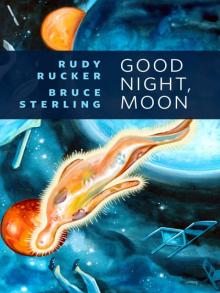 Good Night, Moon
Good Night, Moon Transreal Trilogy: Secret of Life, White Light, Saucer Wisdom
Transreal Trilogy: Secret of Life, White Light, Saucer Wisdom Complete Stories
Complete Stories The Sex Sphere
The Sex Sphere Surfing the Gnarl
Surfing the Gnarl Software
Software Mathematicians in Love
Mathematicians in Love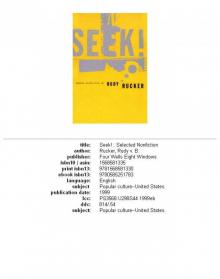 Seek!: Selected Nonfiction
Seek!: Selected Nonfiction The Secret of Life
The Secret of Life The Hacker and the Ants
The Hacker and the Ants Postsingular
Postsingular Spaceland
Spaceland Transreal Cyberpunk
Transreal Cyberpunk Sex Sphere
Sex Sphere Spacetime Donuts
Spacetime Donuts Freeware
Freeware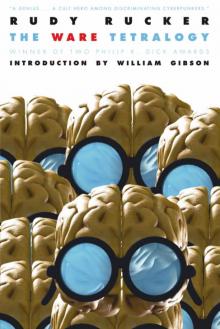 The Ware Tetralogy
The Ware Tetralogy Frek and the Elixir
Frek and the Elixir Junk DNA
Junk DNA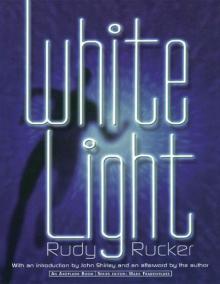 White Light (Axoplasm Books)
White Light (Axoplasm Books) Nested Scrolls
Nested Scrolls Inside Out
Inside Out Where the Lost Things Are
Where the Lost Things Are Mad Professor
Mad Professor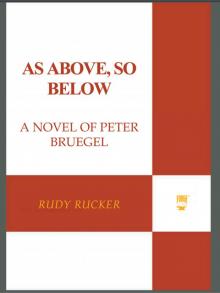 As Above, So Below
As Above, So Below Realware
Realware Jim and the Flims
Jim and the Flims Master of Space and Time
Master of Space and Time The Big Aha
The Big Aha Hylozoic
Hylozoic